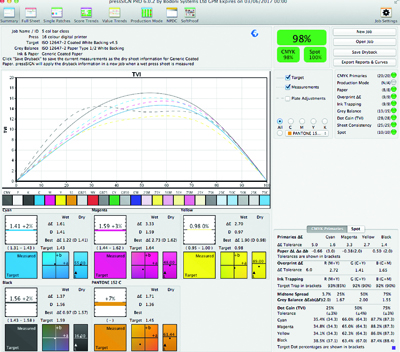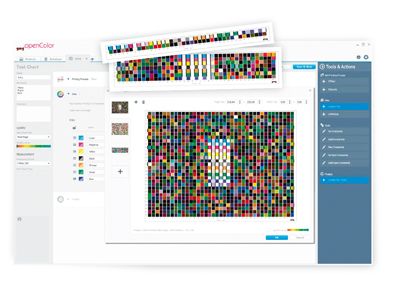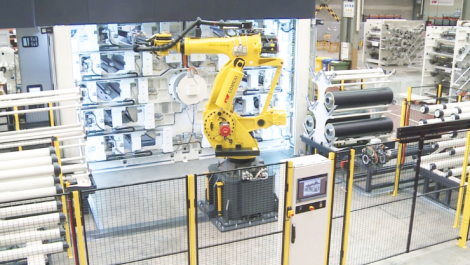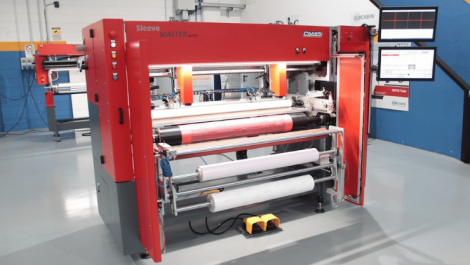From compact strip to multi-page test chart
One of the great strengths of the flexo process is the sheer range of different inks and substrates available, but this also means that good colour management is essential to maintain accurate branding across products. By Nessan Cleary.
Good colour management is all about consistency, ensuring that the same colours can be accurately reproduced from proof to press run, and from one run to the next, even across multiple sites. Consistent colour is particularly important to packaging as most consumers can spot even slight differences in the brand colour from one pack to another, resulting in those packs being left on the shelf.
Flexo is a more challenging process than most, partly because of the sheer range of inks and substrates that are available as well as the large number of spot colours that are used. This has made it difficult to develop and apply standards that will work for all substrates so that the expertise of individual printers and consultants is much more valuable.
Matchmaking
Good colour management is absolutely essential right across the board from designers through to repro and printing, as well as for proofing and prototyping. This differs from litho printing, where most ink and media suppliers work to the ISO 12647 standard so that it is relatively easy to calibrate presses to a known target.
Mark Anderton, managing director at Colour Engine, said that in many cases printers rely on a general standard, such as Fogra 39L, and then have considerable trouble getting the presses and proofs to match their files. The obvious solution is to fingerprint the presses but this can result in thousands of ICC profiles. Mr Anderton argues that a better option is to use a colour server with device link profiles, such as the Alwan ColorHub to overcome this issue.
ColorHub first appeared back in 1996 and was one of the first colour servers designed specifically to cope with the then recently created ISO 12647 standard – Colour Engine is Alwan’s UK distributor. It is a highly respected system that supports multi-colour printing and simulates spot colours with process colour builds. There is a choice of several editions for e-media, pre-press and press uses, and options for proofing and the multi-colour separations. It also includes ink saving, which Alwan claims can cut ink usage by up to 40%.
Mr Anderton said that one of its main features is support for dynamic device link profiles. He explained, ‘When we build the device links, Alwan can apply special rules for every single image in the job. So you might need a certain level of grey colour removal, or GCR, or to have a certain spot colour rendering within the file and these can all be dialled in.’ The system also applies a control strip to the edges of a print that operators can measure to check for accuracy.
Another common problem with the flexo process is that the quality of the dots on the flexo plates can be compromised, leading to many hours of manual retouching to correct. But the most recent edition, ColorHub 5, now includes an optional flexo module that can automatically fix some of these problems. Mr Anderton explained, ‘It can tidy the contaminated dots out of the highlights and repurpose them in the tonal range of the rest of the file.’ He added, ‘Flexo is very complicated because of the different substrates and inks. You can never automate everything so there will almost certainly be some manual work needed, but if you can do 80% of the work automatically then that helps.’
Soft proofing
Most people within the packaging sector still prefer to use a hard copy contract proof. But there are some advantages to using a soft proofing system. Proofing on screen can save a lot of time, and also is accessible to everyone in the supply chain, regardless of where they are located. However, the biggest problem remains having to rely on everybody having a monitor calibrated to the same standard.
Colour Engine also sells Remote Director, a soft proofing solution that is browser-based and allows for on-screen verification of colour accuracy to ensure the monitor is calibrated. It uses ICC profiles to simulate brand colours accurately but also includes a spectral engine. Mr Anderton noted, ‘To get the white point of a file to match the monitor takes a lot of special knowledge.’
Toby Burnett, managing director of GMG UK, agreed that soft proofing is becoming more important, pointing out that as many brands are now looking at printing increasing numbers of shorter runs in order to run promotions on their packaging, so the value of each separate SKU is less. However, he said that many brands might use a soft proof to approve artwork in order to speed up the process but that people still prefer a hard copy for a final contract proof.
But Mr Burnett said that many customers do invest in putting in a managed proofing system on site in order to be able to record the values they are printing to centrally. He also said that there is more globalisation and so a lot of brands are trying to harmonise the look and feel of their packaging across different regions. This in turn is leading to a need to share the colour information across different sites.

Esko has a number of tools, such as Equinox, to convert spot colours to a fixed ink with an extended gamut
Opening the colour
GMG is another highly respected brand and has a number of colour management solutions. This includes ColorServer, which provides automated colour conversions based on device link profiles. GMG has long argued for the use of device link profiles, which hardwire the source and destination profiles for a more accurate result. There is also SmartProfiler for the calibration and profiling of various devices, such as proofers and flexo presses.
Mr Burnett said that another product, OpenColor, has a big opportunity in flexo printing. This uses a centralised database to manage spot colours and can produce multi-colour profiles. It can read in data on inks and substrates and on the target press in order to build a proofing profile. He commented, ‘With OpenColor we can build a spot colour profile. We use a mini wedge to print that data and to get the spectral behaviour of the press and compensate for dot gain so we don’t have to build a full profile.’
GMG has just updated OpenColor, which now links to its ColorProof proofing solution. It is now possible to create individual multi-channel test charts, which can be measured within the application. It is also easier to manage profiles for a particular job and to ensure that only the approved profiles are sent to production.
Mr Burnett also pointed out that brands increasingly need to match the flexo printed packaging with items printed through other processes, such as point of sale display advertising. He said, ‘We have people that use our system for colour management in flexo but it tends to be as part of a process to get colour right across different devices.’
Making adjustments
Ian Reid, managing director of Bodoni, takes a different approach to most vendors, saying that despite the lack of standards there is no significant difference between litho and flexo, adding, ‘It’s just more difficult to adjust the volume of ink during the production run with flexo.’ He said that as you move away from substrates that match the 12647 standard, it does become more difficult, but added, ‘With our software you can select the target but make the CMYK elements dependent on the underlying substrate so that it all automatically adjusts for the substrate which gives you a much better connection between what was originally proofed and the printing when printing to substrates like board or foil.’
Bodoni is a British developer of colour management solutions. This includes PressSign, which can measure any combination of patches on a print and deliver the data to a print or brand management company anywhere in the world. Mr Reid explained, ‘So it will tell the printer if he’s achieving the target set by his customers and also how to make adjustments.’
The system contains values for Pantone spot colours and others can be loaded from a central server, allowing for up to 12 spot colours. Mr Reid said that it is a comparatively inexpensive solution and that it is widely used by packaging printers worldwide. He pointed out that as it is a server to server solution everyone is using the same version and printers are free to use it for all their work. It can be licensed from one month to three years, so many users only pay for it when they actually need to use it.

Bodoni PressSign can automatically compensate for the effects of the underlying substrate
Colour libraries
As we’ve noted, most flexo printers will have to cope with many thousands of different profiles for individual combinations of inks and substrates, and simply managing this number of profiles can be a major headache.
Esko has developed Color Engine, which is a database for storing colour data. David Harris, product manager for colour and proofing at Esko, said, ‘We have made a lot of improvements to this recently. We added an automated colour refining wizard that works with spectral data so that you can automatically refine your colours on press while still keeping the benefits of spectrally measure data. This means that storing the spectral data for individual inks allows you to predict what happens if you mix two colours together.’
Esko’s Color Engine can be used together with several other applications, such as pre-press editors, proofing RIPs and automated workflows, which can all access its colour data. There are also a number of cloud-based libraries that offer similar functionality. These allow standardisation across the supply chain as everyone can access the same spectral data for the inks without having to make their own measurements.
Esko has developed a direct connection with Pantone Live, but Mr Harris said that other systems can access the Color Engine database through the CXF format.
Pantone Live is probably the best known of the various cloud-based colour management options. It has been developed by X-Rite, which owns Pantone, but working with a range of vendors from different areas of the supply chain. Essentially it gathers all the data on different colours together into a single online database that can be accessed by everyone in the supply chain. Naturally it contains data for all the Pantone colours, together with ink formulations from several ink vendors, including Sun Chemical. But other ink vendors, such as Paragon Inks, are also working to create data sets for its inks within Pantone Live.
Amanda Jones, sales manager at Paragon Inks, said, ‘We have matched our colour library to the digital Pantone Live library so that the CXF file data, such as for a specific red is much more realistic and we get to the Delta E that is required from the brand owner.’ She said that a database of colours isn’t just about how good the base colours are but how well you understand how each of the colours mixes together, adding, ‘The biggest thing we take time over is the extent of how each colour affects other colours.’
MatchMyColor has developed an alternative cloud system, Colibri, which is also gaining popularity. It is based around a central database and users can add further modules depending on their needs. These include, ColorSpec, for specifying brand colours and standards; ColorMatch, for matching colours on different substrates; ColorQuality, for monitoring and certifying colours; and ColorTint for controlling colour recipes in production. MatchMyColor is a Swiss company, but Colibri is distributed in most regions worldwide by Konica Minolta Sensing.
Extended gamuts
Mr Harris said that there is a growing trend toward the use of extended gamut printing, with an inkset of up to seven colours. This does away with the need for spot colours reducing the number of inks that have to be stocked and the makeready times between jobs. It is mainly seen in label printing and flexible film packaging where higher screen rulings are used. Mr Harris explained, ‘Flexo is evolving towards higher definition, more accurate registration of the presses and better screen rulings. This is making it easier for the printer to work with extended gamuts.’
But he noted that this does require colour management tools. Thus Esko has developed pre-press editors, such as ArtPro and PackEdge, of which he said, ‘We have specific features to automatically convert files to expanded gamut so that we get accurate colour matches. The software calculates a certain set of ink percentages to give the most accurate result but if that contains, say, 4% of black then it might be better to remove that 4% to make it easier to print. So it is not just calculating the theoretical best build but also taking into account the printing process.’
But Esko also has a tool to reduce the number of CMYK colours whilst working with spot colours. Ink Tools is a Photoshop plug-in that can help replace, for example, magenta with a spot red, balancing out the separations to match the colours. Mr Harris said that you could measure the ink or take the data from a library like Pantone Live, adding, ‘It applies colour management and gives you a soft preview in Photoshop.’ He accepted that you could achieve a similar affect through making curve corrections but said that this a more straightforward approach.
Graphic Republik, which specialises in pre-press, colour conversion and proofing solutions developed specifically for the packaging sector, sells an alternative called MaxColor. This is a feature within the MaxPro software suite that allows you to substitute some of the CMYK colours with the spot colours used in a given job. Steve Donegan, managing director, said that this saves on the number of plates used for a job, adding, ‘If you can print with less colours then you get better trapping.’ He said that it works directly from the Pantone spot library whereas Photoshop uses RGB and CMYK values for reference.
MaxColor won the 2011 FlexoTech Award for Innovation in Pre-press. At the time, the judges said, ‘The winner is an innovation that clearly moves the game on, with far reaching potential in several aspects of flexo printing. Its commercial benefits are matched by environmental improvements, which all add up to greater efficiency and higher productivity without any loss of print quality. It offers reductions in ink and substrate consumption, the use of fewer plates, and allows jobs to be produced by fewer print units that consume less energy – in a nutshell, it is hard to see a downside – great innovation!’
Conclusion
There is a widespread belief that the flexo industry lacks the kind of practical standard that has allowed offset printers to get a grip on their colour management. This ignores part six of ISO 12647, which deals specifically with flexo printing for packaging. However, the sheer number of substrates, inks and even printing methods renders any attempt at a standard meaningless. The ISO committee recognised this and revised the standard back in 2012. Steve Donegan summarised the situation thus, ‘The committee concluded that it couldn’t achieve a standard because of the variety. So they said that an agreement should be made between all parties as to what can be achieved from a particular process, with a particular ink and substrate.’
He said that this is a practical approach, noting, ‘Some standardisation has to come in and the only way we can do this is to take readings and be able to reproduce the data to have consistency.’ He added, ‘For me, the key consideration for flexo colour, process and print management lies in the ability to capture statistical information and ensure all processes can reproduce the same data each time a job is run.’
In the meantime, as Mr Harris pointed out, ‘Good colour management depends on good process control and that’s one of the things that we try to help customers understand.’ But this process control will have to include measuring everything from ink draw downs through to press samples to ensure consistency. This applies equally throughout the supply chain from ink manufacturers through to converters because good colour management depends on all these processes coming together.






